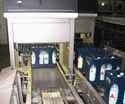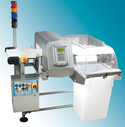Getting the product to its destination
28 October 2008Various types of conveyors are used in packaging systems that must handle products carefully and efficiently. Packaging Today considers some new developments.
Conveyor systems are used throughout packaging lines and must fulfil numerous demanding criteria, including gentle handling, elimination of product contamination and maximum efficiency, with minimal downtime. Increasingly, conveyor suppliers are supplying turnkey solutions, such as those involving robots.
A sweet solution
CKF Systems has recently been awarded a ú1.2m contract by confectionery manufacturer Cadbury to supply an automated robot palletising system for its Sheffield factory. The order includes the conveying of cases from eight existing production lines. CKF states that the system can supply individual flow rates of up to 22 cases per minute through to three robot cells and a pallet handling system, including a pallet dispensing system and stretch wrapper.
The case handling system includes a series of lines, each of which comprises a spiral elevator and high level transfer system to deliver cases to the robotic palletising system. Spiral conveyors are being used to lift the variable range of case sizes, and flow rates, to a high level whilst occupying minimal floor space. The cases will be delivered on high-level independent conveyor systems, declining prior to the robot cells, where the cases are collated to the appropriate format prior to picking up by the robotic gripper.
The robotic palletising operation will incorporate three ABB IRB 660 robots fitted with vacuum grippers, controlled by the Pick Master 5 palletising program. CKF states that the system can handle three separate pallet sizes _ Chep UK, Euro and the Chep USA pallet. The pallet distribution system comprises three destackers, one for each pallet size, feeding single pallets on a common shuttle car that delivers them to the appropriate robot station on demand. Each robot station incorporates multiple pallet conveyor arrangements, incorporating a hold station for empty pallets; pallet load station with positive datum location and a buffer position for loaded pallets, prior to loading on a second shuttle car for full pallets.
Loaded pallets are received from each of the three stations on a shuttle carriage and delivered to a new high speed stretch-wrapper unit, the infeed for which includes a short buffer section and turntable to present the pallets in the appropriate orientation. Stretch-wrapped pallets are dispensed on an accumulation section prior to removal/transfer for despatch. According to CKF, the system had to take into account a range of case sizes, flow rates and 23 different pallet patterns, being configured to operate in a confined operating area with a low ceiling.
No need for lubrication
Tsubaki has developed a range of lubrication-free oil-impregnated sintered roller chains and engineered plastic/stainless steel combination chains. These have no rollers; instead relying on the self-lubricating properties of the polyacetal inner links. The company claims that these eliminate the requirement to use external lubricant and can extend the wear-life of conveyor equipment. Tsubaki also believes that they protect food products and packaging from marking and contamination, and can reduce operating costs as there is no need to use food-grade lubricant.
The company reports that a depalletising machine in a large UK butter processor is currently using a Tsubaki Lambda corrosion-protected drive chain. Each machine is washed down using high-pressure salt water at 70¯C following each shift.
Beauty and the conveyor
The Merseyside-based company Cobalt Conveyors was launched last year. This summer Hallam Beauty in Yorkshire needed to install a larger, new conveyor system in order to supply a hair and beauty range to a leading supermarket chain. They requested that Cobalt Conveyors design a full turnkey system, incorporating existing equipment, such as a filling machine, shrink wrapper, labelling machine, capping machine and date coder.
Cobalt drew up detailed plans for the new proposed conveyor and, following additional requirements from the client, these formed the blueprint from which the new conveying system was manufactured. Cobalt also supplied a bespoke control panel for the system. The team oversaw the manufacturing schedule and also fully installed and commissioned the line, both mechanically and electrically.
Cutting out sticking
The Heat & Control FastBack 260E has been designed for use by processors of fresh cut-leaf salad and spring mixes. The company claims that the system eliminates bruising, damage and sticking and does not require operator adjustment, operating without flexure or the necessity for variable speed tuning. Heat & Control claims that the 260E can convey heavy loads at up to 12m/min and that the slow-forward fast-back motion safely transfers product without sticking in the pan or layering of pre-mixed components.
The washdown drive arrangement handles weigher feeding, distribution, sorting, and many other applications. The company states that it can be adapted to different pan sizes and configurations, following the changeover of equipment layouts. The system is supplied prewired and plumbed, with all electrical and pneumatic components being mounted in the conveyor base. According to Heat & Control, the FastBack delivers a consistent amount of product and can work effectively with a multihead weigher.
Riley Automation has launched its F-T02 Linear Vibratory Feeder, designed to overcome problems relating to feed resistance and low output for products that are soft, flexible or sticky, such as salad/leaf products. According to Riley, the F-T02 system operates at high amplitude and can maintain a high stroke and product travel speed, even when operating with a significant head-load. Depending upon the product being processed, the system is said to have a maximum capacity of 10 tonnes/hr.
No stopping for tea
Unilever Polska recently searched for a new conveying solution to transport tea in one of its packaging facilities. The tea was being transported by a bucket conveyor over a distance of 15m, with the conveyor vertically rising by 5.5m, reaching a capacity of three tonnes/hr. Mariusz Gradowski, Senior Area Engineer, Unilever Polska, commented:
"The bucket conveyor was proving to be an inefficient solution. It would break down approximately once a month, which resulted in nearly a full workday of downtime, affecting the entire production line and mixing shop." The system was also losing approximately 100kg of tea per shift, equating to two per cent of total product.
Unilever Polska decided to work with conveyor manufacturer PIAB to find a solution that would increase productivity by reducing downtime and product loss, together with reducing dust in the production facility. The company installed two VCP1600 vacuum conveyors equipped with adapters and a de-dusting system. Gradowski commented: "It's a fast, enclosed solution that has proven to be much more reliable than the bucket conveying system. We have nearly eliminated downtime that was causing a business loss of _8,400 (ú6,535) per month."
Pharmaceutical quality
Ceia (part of Constant Instruments) has launched its Multi-Spectrum metal detection technology which applies pharmaceutical inspection standards to the food industry. The new Ceia THS/21 multi-spectrum metal detector has no preset frequency zones, featuring universal frequency selection, enabling the metal detector to adopt the required frequency for any product type. It is said to be successful in inspecting food products with highly conductive properties that may otherwise prove difficult to inspect.
New software is also being used in conjunction with the Ceia THS/21. This is designed to provide inspection traceability records by generating detailed evidence of applied Due Diligence by being compliant with the CRF21 Parts 10 and 11 standards commonly employed within the pharmaceutical industry. Ceia claims that the system increases the degree of achievable sensitivity by up to 30 per cent for the detection of metal contaminate particles in products that had hitherto proved difficult to inspect.
A flexible solution
Wire Belt has augmented its range of flex turn units by launching the 580 series, which features an 800mm inside radius small-pitch belt. The company claims this is suitable for handling small or delicate products across the full belt width. The pitch is 6.5mm at the inside radius and up to 10.5mm at the outside radius, with a wire diameter of 1.6mm. Wire Belt claims that the unit can be easily cleaned, as it features stainless steel belting and a support surface. It will initially be available in belt widths of 400, 600, 900 and 1000mm.
The Flexlink X85 conveyor chain system features smooth guiding surfaces and is said to offer a long service life and generate low noise levels, due to the slide rail geometry and reduced contact pressure between the chain and slide rail. The slide rails feature chain side protection, designed to provide additional safety. Flexlink claims that the flat top surface provides easy transfer through the bend, even for larger products. According to the company, the system also features distributed line control, designed to work at high speed, yet giving soft starts and stops and facilitating gentle product handling.
Lots of bottle
Excel Automation has recently completed the third phase of an upgrade to the palletisation and automatic despatch facility for drinks producer Chivas Brothers at its Kilmalid site in Dumbarton. All four phases were won by Excel Automation and the upgrade is designed to achieve an estimated 50 per cent increase in output. The project included eight new production line conveying systems to transport different-sized cartons, containing a variety of bottle sizes, being conveyed from the existing bottling plant into a new palletising plant where they are automatically sorted into pallet profiles. According to Excel, the conveyor systems and eight high-level palletisers operate at high speeds, and thus pallet stability was an important consideration. Before cases enter the eight new palletisers, a lock and pop system sprays the tops of cartons with a cold glue to hold each layer together as a stable block, prior to delivery to the wrapping area.
Over 1000m of Excelveyor 500 belt-driven carton conveyor were installed. Every 600mm section up to the palletising area is equipped with a soft-start system to prevent bottles breaking and liquid spillage. Excel claims that all conveyors are programmed to operate with the softest contact. From the bottling plant, cases feed into an accumulation tunnel that allows pallet loads to be built up and transported to the palletisation and despatch building, where incline conveyors carry them to high-level in-feeds for the palletisers.
When cases enter the palletisers, a layer is formed and placed on Chivas' own pallets, which are fed by one of two Excel pallet conveyors into two destacking machines that distribute individual pallets to four of the eight new palletisers. The second pallet conveyor transports loaded pallets from the palletisers to wrapping machines. Phase 3 began just before Christmas 2007 and the system became operational by April 2008. Stephen Trainor, Project Manager, Chivas Brothers commented that a significant advantage of Excel's proposal was its dual-line design, which fitted into the existing building and could be constructed whilst the previous system was in operation.
A complete pizza solution
Conveyor Systems was awarded a contract for the design, manufacture, supply and installation of a new product handling system to transfer individual or stacked pizza film wrapped bases between high- and low-care food quality areas. In a high-risk area located on the first floor, conveyors must interface with two film wrappers and transport pizza bases ranging in diameter from 8_14 ins (203_356mm) downwards, via an overhead conveyor in a high-care area and into a low-care ground floor packing hall.
The company designed a special modular plastic matt declining conveyor, fitted with FDA-approved high-friction gripper inserts to prevent the film-wrapped pizza bases slipping during their descent from the first floor. The conveyor was constructed from food-quality stainless steel, with a single frame carrying two individual lanes of modular matt conveyor. Conveyor Systems states that this provides maximum flexibility, enabling each flow-wrapping line to operate independently.
In the high-care area, the modular plastic matt conveyor continues in a long overhead run, designed with strengthened supports to ensure an open operating environment with minimum obstructions to workflow and access. At the end of this span, the film-wrapped pizza bases are conveyed through a wall and down a decline into the low-care packaging hall. At floor level, the single frame conveyor splits to feed two packing stations, each of which has two tiers.
Operating from hand-packing stations, the packers place wrapped pizza bases in cardboard cases, passing these through case-sealers prior to hand palletising. Downstream from the packing stations, a series of powered roller conveyors take the product through a series of integrated metal detectors, case weighers and case sealers. This system also facilitates the packing of wrapped pizza bases in RTE plastic trays, thereafter being palletised for despatch.
New conveyor types
Flexy has launched its powered roller expandable conveyor, designed to provide a rapid controlled flow of goods, driven by a Sew EuroDrive AC motor. The company claims this can achieve outputs of 10_40m/min with 0.09Kw from a single phase supply. The conveyors can be fitted with under-roller photo optic sensors to facilitate indexing or zero-pressure accumulation. Flexy powered and gravity modular conveyors are available in two standard widths of 600mm and 700m, with an optional 900mm width for handling larger-dimensioned products. The company states that these versatile expandable conveyors are used for a variety of materials handling applications, including loading/unloading vehicles and warehouse and factory handling applications, in addition to linking assembly and packaging machinery.
Rexnord has launched an addition to its SuperGrip series, known as the SG 1005 Tough Composite Friction (TCF), designed as a metering and break conveyor for returnable crates. According to Rexnord, the TCF top has proven to be two to three times more wear-resistant than acetal in specific applications. The clips to retain the metal rods are flush with the belt edge and are not exposed on the top belt surface. The reusable clip closes the hinge eye completely, resulting in a secure lock and permitting operation from the side and from below. The TCF belts incorporate stainless steel pins, claimed by the company to enhance elongation resistance (wear of hinge and pin).
Hapman has recently installed a Tubular Drag Series C Conveyor to a food processing and packaging company. This had previously used an aeromechanical conveyor, which it claims resulted in clogging, jamming and shutdowns. The company states that the Hapman Conveyor can run for 24 hours a day, using a stainless steel round-link chain. Hapman states that this negates the fraying and flaking that emanated from the previous conveyor.
No room for complacency
Conveyors and conveying are elements of the packaging industry that leave much room for innovation. As automation expands across all industries, entire production lines are becoming completely reliant on conveying solutions, which must be reliable, require minimal maintenance and have high hygiene qualities. The latest generation of conveyor systems are designed to minimise downtime and to withstand a very wide range of environments and temperatures.
Tsubaki plastic/steel combination chains rely on the self-lubricating properties of the polyacetal inner links No need for lubrication Heat & Control claims that the FastBack 260E eliminates bruising, damage and sticking to fresh cut-leaf salad and spring mixes Salad doesn't stick The F-T02 Linear Vibratory Feeder is designed to overcome problems related to feed resistance Resistance is low The new Ceia THS/21 metal detector features universal frequency selection and can be used for any product type, according to the manufacturer Eliminating contamination The Flexlink X85 is said to feature reduced contact pressure between the chain and slide rail, reducing noise and extending service life Reducing pressure Excel Automation installed eight new production line conveying systems at Chivas Brothers' Kilamalid site Many conveyors make light work The Rexnord SG 1005 Tough Composite Friction belt is designed as a metering and break conveyor for returnable crates A tougher type of belt








